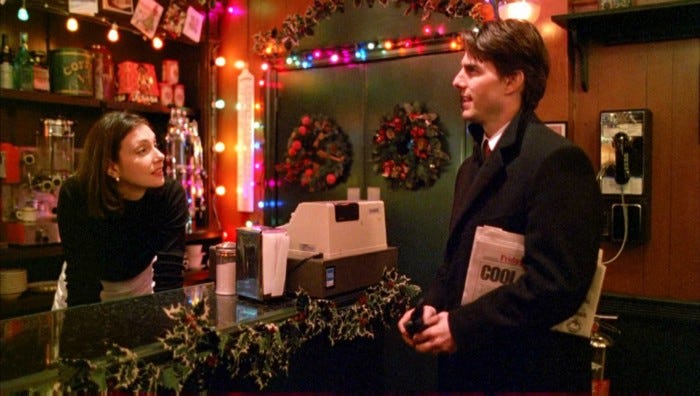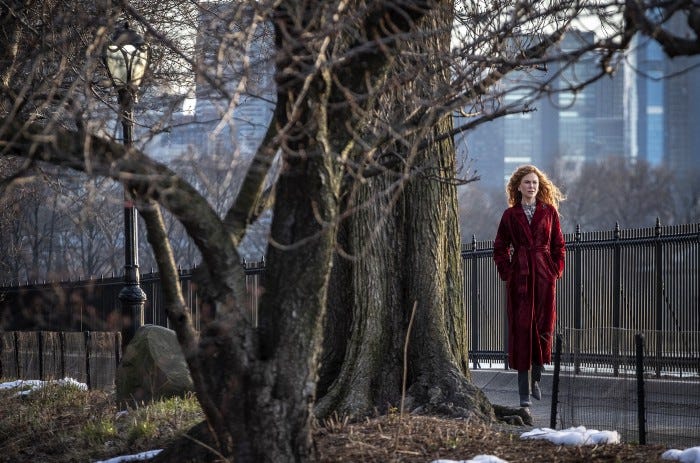Eyes Wide Shut: A Magical Realism Holiday Movie
A Christmas-set family drama with sexual overtones and a pastiche of the mystical encounters and plot twists
The setting is a festive street in a metropolis, as an individual walks on the sidewalk utterly alone. They are eclipsed by the glow of a holiday sale in a storefront window while laughing children in knit scarves brush past, eating a festive sweet, relishing the jubilant atmosphere, unaware of this introspective darkness. The lone person, clad in an expensive wool coat, is financially well-off, moderately attractive, and successful in their field, but one wouldn’t know that from the misbegotten shuffle of their feet, or sad eyes masked with an aggressive stare. The individual is named Ebenezer Scrooge, Doris Walker, Louis Winthorpe III, or even Dr. William “Bill” Harford or Dr. Grace Fraser. A Christmas tale comes in many forms, but none more potent, or faithful to the genre than a tale of magical realism and self-discovery. The scene described is one I’ve found in several films within the holiday blockbuster canon. It’s first and foremost a suspense or drama, elevating the darkest corners of its characters’ psyches and revealing a hard-fought truth by the culmination of its plot all set during Christmas-time in New York City. Eyes Wide Shut (1999) is the film, and it is truly emblematic of the holiday genre.
The celluloid legacy of the Holiday Movie is as lengthy and saturated as film history itself. The first appearance of Santa Claus on film was in an 1898 British silent film entitled Santa Claus. The character’s most recent is the 2020 Netflix film The Christmas Chronicles 2 starring Kurt Russell as our bearded hero. The Christmas-themed content created in the last 120 years is voluminous and far-reaching, with Santa Claus as one of several images or figures representing themes of family, graciousness, and renewal. A far more detestable character from Charles Dickens’ A Christmas Carol is Ebenezer Scrooge who has been immortalized in twenty films, and over forty-nine television adaptations. The classic tale is one where supernatural elements and the bizarre lead a miserly man to the path of self-actualization and forgiveness. Much like the magical realism in O. Henry’s story “The Gift of the Magi,” Scrooge’s story is a widely known parable for selflessness and humanity, a mascot as prolific as Santa Claus, but more human and transformative.
At its core, the genre embodies these timeless themes anchored in a decadent, winter backdrop. Any film with these shared symbols and language related to the tale of a soul-searching wealthy man seeking redemption before the New Year, or lovers reckoning with their shortcomings ahead of a day of togetherness are emblematic of the Christmas narrative. In the year 1999, Stanley Kubrick’s final film, Eyes Wide Shut, was released into theaters with an exciting and bizarre take on a New York couple. It’s a suspenseful narrative of an isolated man, reckoning with a fractured marriage during the holiday season only to encounter a bizarre sexual cabal of the affluent that drives him into an abyss of self-reflection and discovery. The film is a Christmas-set family drama with sexual overtones and a pastiche of the mystical encounters and plot twists; the quintessence of the Christmas season narrative.
Our lead character of Dr. Bill Hartford, played by a career-pinnacle Tom Cruise, is suffering from his wife’s disclosure of an extra-marital fantasy about a stranger from a past family vacation. A mysterious, delicate Nicole Kidman who was married to Cruise at the time of filming, embodies the subdued, yet volcanic nature of a spouse’s admission of deviance. It’s this inciting incident that leads Dr. Hartford to roam the streets of festive Manhattan, whose urbanity is hued with the colored glow of Christmas lights.
What the rest of Eyes Wide Shut conveys is this sense of mystery and erotica, a slow burn the likes of Gabriel García Márquez, but with the backdrop of a frosty New York City instead of a South American locale. Dr. Hartford has eerie encounters with acquaintances in the vein of Scrooge, as his past seems to manifest serendipitously with those he meets. This includes an old medical school colleague who is now a pianist at a Christmas party who invites Bill to an underground orgy for the wealthy. The pianist is an avatar for another life and a guide into the surreal. Another meeting is his affluent patient’s drug-addled lover whom we meet at the start of the film incapacitated. Dr. Hartford attends to her, only to disturbingly see Mandy dead from an overdose in the morgue later. Each meeting starts as odd but becomes darker as the narrative progresses almost correlated to the void Scrooge must muddle his way through in each visit by the Ghosts of Christmas Past, Present, and Future. The motif of the abyss follows our holiday protagonists and that is what solidifies these stories as the holiday genre. A fantastical place inside the mind, scary, and swimming in a reality that feels suspended in time, trying to uncover the truth. Abyss occurs in various forms of literature, but in our reality, the backdrop can be any setting where time is suspended. In 2020, but most years, Christmas has that feeling of suspension from the present: a time of reassessment of the past, relationships, and rekindling. These themes are almost indistinguishable from the theme of Christmas itself. It’s magic, and the more shadowy the chasm the brighter the illumination.

The notion of a film neatly fitting into the “Christmas” category is lofty in our postmodern era. While there are shared features, ultimately I think it’s the themes of self-reflection and selflessness, and a mystical, reality-rooted winter setting that determines a movie’s identity as holiday-themed. What O. Henry’s “The Gift of the Magi,” or the other countless Christmas tales employing magical realism show us, is humility and relationships are paramount to happiness. In any contemporary stories of love, loss, and discovery with a December setting, the holiday spirit is alive and well. One could argue that HBO’s The Undoing similarly conveys this like Eyes Wide Shut, except this time Nicole Kidman takes center stage as the explorer, rather than the catalyst, as her character wanders through the landscape of Manhattan, her own urban void. While the story does not take place around the Christmas season, its wintry backdrop and family core present the same motifs in a yuletide gaze. Eyes Wide Shut achieves this same feat, doing so in a much more fantastical thematic tone, but also as a much more lush and fulfilling story.
Eyes Wide Shut is another entry in the holiday canon. Its emotional darkness amongst a sardonic Christmas atmosphere, its characters will find the light, even if they encounter a psychological nightmare to get there. Even in the murky, at times chilling moments of doubt, a magical, luminescence will guide you to resolution.






